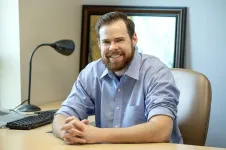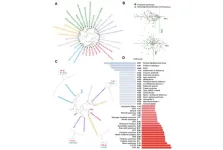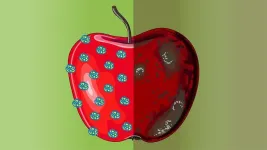(Press-News.org) Oak Ridge National Laboratory’s managing contractor, UT-Battelle, presented a donation of $186,000 to Socially Equal Energy Efficient Development, or SEEED, to support the nonprofit’s third green solar home as part of their Green Construction Program.
“We are committed to serving the communities that we live in,” UT-Battelle CEO and ORNL Director Stephen Streiffer said. “Our partnership with SEEED has provided a tremendous opportunity to share our scientific expertise, and we are excited that our support will help make this green solar home become a reality.”
Streiffer joined SEEED for a groundbreaking ceremony in Knoxville, Tenn., at the home project site. He recognized SEEED’s efforts in creating housing equity while encouraging the distribution of clean energy benefits to the community.
“Oak Ridge National Laboratory has been a valuable supporter of SEEED through the volunteerism of its employees, and we’re very grateful for this generous financial contribution from UT-Battelle,” said Stan Johnson, founder and executive director of SEEED. “Together, we’ll make a difference for a family, for the workers we’ll train in green building methods, and for the larger community as we rise together.”
SEEED is a registered 501(c)3 seeking to provide young adults pathways out of poverty through career readiness training, environmental education and community engagement. As part of their Green Construction Program, SEEED develops green solar homes that are sold below market value to low-income families, creating equity and giving them the opportunity to build generational wealth. Currently, two homes have been built, and SEEED seeks to construct about 10 more over the next three years.
Along with the monetary donation, researchers with ORNL’s Buildings and Transportation Science Division offered technical guidance towards developing best practices for green building design based on experience with the energy impact of building materials and equipment used in constructing the home – with the goal of reaching net-zero energy consumption.
SEEED will leverage ORNL’s expertise in the energy-efficient design of high-efficiency materials and equipment. The home’s design will include advanced techniques such as 2x6 framing combined with an insulated concrete form basement (a feature that will boost the amount of insulation), a solar panel system with battery storage, a high-efficiency heat pump water heater and HVAC system, low-energy LED lighting and energy-efficient appliances.
ORNL scientists are participating in another SEEED project for better understanding of urban microclimate change, and they are lending time and expertise to development of SEEED’s Edible Forest Program, or EFP. The Edible Forest supplies fruit trees, vegetables and herbs to the community at the epicenter of a 2-mile radius food desert. The EFP hosts community events and a bootcamp for young adults, providing them with skills in sustainable agriculture.
UT-Battelle manages ORNL for the Department of Energy’s Office of Science, the single largest supporter of basic research in the physical sciences in the United States. The Office of Science is working to address some of the most pressing challenges of our time. For more information, please visit energy.gov/science. – Natori Mason
END
UT-Battelle donates $186,000 to support SEEED’s green construction program
2024-02-21
ELSE PRESS RELEASES FROM THIS DATE:
Spinning, magnetic micro-robots help researchers probe immune cell recognition
2024-02-21
Researchers at the Pritzker School of Molecular Engineering and the Department of Chemistry at the University of Chicago have engineered tiny, spinning micro-robots that bind to immune cells to probe their function. The robot, or “hexapod,” gives scientists a new, highly adaptable way to study immune cells and to aid in the design of immunotherapies against cancer, infection, or autoimmune diseases.
Each hexapod robot has six arms containing molecules that might be recognized as foreign by the immune system — such as protein fragments from a tumor, virus, or ...
Helping patients with low income overcome eating disorders
2024-02-21
Individuals with eating disorders who have low income are frequently misdiagnosed and lack adequate access to appropriate therapy, according to researchers from Weill Cornell Medicine and Columbia University Vagelos College of Physicians and Surgeons.
Their paper, published in The Cognitive Behaviour Therapist on Feb. 19, identified the barriers to care that come with having low income and offered guidelines on how therapists can make accommodations for these patients to improve diagnoses and access to treatment.
Approximately 30 million people in the United States experience ...
Preventing relapse by restoring an opioid-weakened brain pathway governing behavior
2024-02-21
Medical University of South Carolina scientists report in Neuron that they have uncovered a way to restore an opioid-weakened brain pathway in a preclinical model.
With funding from the National Institute on Drug Abuse, part of the National Institutes of Health, the MUSC research team, led by neuroscientist James Otis, Ph.D., used advanced neuroscience tools to return a pathway between the thalamus and basal ganglia to healthy functioning in mice. As a result, this restoration prevented mice that were opioid-dependent from seeking or self-administering heroin. Results also suggested that sustained opioid use was the cause of this weakened pathway, rather than being caused by ...
Water quality monitor, locust-inspired electronic nose under development
2024-02-21
By Beth Miller
Two teams of engineers led by faculty in the McKelvey School of Engineering at Washington University in St. Louis will work toward developing products to monitor drinking water quality and to detect explosives with an electronic nose with one-year, $650,000 Convergence Accelerator Phase 1 grants from the National Science Foundation (NSF).
Barani Raman, professor of biomedical engineering, and Daniel Giammar, the Walter E. Browne Professor of Environmental Engineering, will lead teams of researchers from Washington University and other institutions and entities funded under the NSF’s Convergence Accelerator program, designed to address national-scale ...
Child tax credits provided significant relief to families experiencing economic shocks during COVID
2024-02-21
Contact:
Jillian McKoy, jpmckoy@bu.edu
Michael Saunders, msaunder@bu.edu
##
As a proposal to reinstate expanded Child Tax Credits (CTC) in the United States awaits a vote in the Senate, a new study led by Boston University School of Public Health (BUSPH) researchers reveals that the now-expired 2021 CTC expansion benefitted families experiencing financial setbacks due to health or employment challenges spurred by the COVID-19 pandemic.
Published in the journal Health Affairs Scholar, the study found that monthly advance payments included in the 2021 CTC ...
Plasma scientists develop computer programs that could reduce the cost of microchips and stimulate American manufacturing
2024-02-21
Fashioned from the same element found in sand and covered by intricate patterns, microchips power smartphones, augment appliances and aid the operation of cars and airplanes. Now, scientists at the U.S. Department of Energy’s (DOE) Princeton Plasma Physics Laboratory (PPPL) are developing computer simulation codes that will outperform current simulation techniques and aid the production of microchips using plasma, the electrically charged state of matter also used in fusion research. These codes could help increase the efficiency of the manufacturing process and potentially stimulate ...
Novel combination therapy offers promising results for treatment-refractory hepatoblastoma
2024-02-21
Hepatoblastoma (HB) is the most common liver cancer in children. Researchers and physicians in the field are concerned because in the last decade HB has been rising rapidly worldwide and has seen the most rapid increase among all pediatric solid tumors.
A team led by researchers at Baylor College of Medicine has been working on improving therapies for this devastating disease. They recently reported in the Journal of Hepatology a novel treatment strategy that produced encouraging results in animal models.
“High-risk disease leads to high rates of relapse and mortality,” said first author Dr. Andrés F. Espinoza, general ...
New study: Defining the progeria phenome
2024-02-21
“In sum, we have defined what a premature aging disease is and developed tools to allow diagnostics of patients and disease population.”
BUFFALO, NY- February 20, 2024 – A new research paper was published in Aging (listed by MEDLINE/PubMed as "Aging (Albany NY)" and "Aging-US" by Web of Science) Volume 16, Issue 3, entitled, “Defining the progeria phenome.”
Progeroid disorders are a heterogenous group of rare and complex hereditary syndromes presenting with pleiotropic phenotypes associated with normal aging. Due to the ...
Low oxygen in lakes may breathe new life into conservation efforts for water quality
2024-02-21
Abigail Lewis traveled all across the United States for college and graduate school, and she ended up researching lakes in her own hometown.
For one of her graduate research projects, Lewis analyzed 656 lakes across five continents with an international research team. The lakes in her hometown of Waukesha, Wisconsin, were among those included.
“To look back and pull together these two parts of my life has been really satisfying,” said Lewis, who will earn her Ph.D. in biological sciences this spring.
In a paper recently published in Global Change Biology, ...
Engineering a coating for disease-free produce
2024-02-21
Dr. Mustafa Akbulut, professor of chemical engineering, has teamed up with horticultural science professor Luis Cisneros-Zevallos to engineer longer-lasting, bacteria-free produce.
According to Akbulut’s recent publication in Current Research in Food Science, the global fruit and vegetable market loses over 50% of agricultural fruit production during various stages of produce handling and post-harvest treatments.
Many fruits and vegetables already have a layer of food-grade wax that is applied for cosmetic reasons and to prevent water loss. Akbulut’s research combines such wax with nano-encapsulated cinnamon-bark ...






